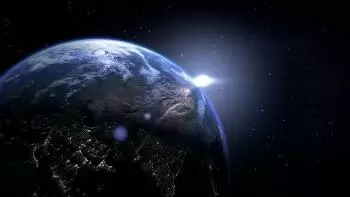
Earth is the planet where we lived the most and is the third planet in the solar system. It belongs to the group of terrestrial planets, of which it is the largest both in terms of mass and volume.
71% of the earth's surface is covered by water in the form of seas and oceans, the rest is made up of continents and islands. Water is necessary for the survival of all known life forms.
The future of the planet is related to the Sun which is the source of solar energy. It is estimated that solar radiation will grow by 10% in the next 1100 million years, generating important consequences on Earth, including the disappearance of the oceans.
The Earth meets all the requirements that a planet must meet to be habitable for complex multicellular life, that is, the existence of a biosphere. Earth is the only planet in the solar system that has a biosphere and originated about 3.5 billion years ago.
The Earth has a natural satellite: the Moon. The diameter of the Moon is about a quarter that of Earth and it has no atmosphere.
April 22 is Earth Day.
How long does it take for the Earth to make one complete revolution?
Relative to the background stars, it takes Earth 23 hours, 56 minutes, and 4,091 seconds to rotate once on its axis. The planet rotates counterclockwise as seen from the North Pole.
It takes the Earth 365 days and 6 hours to make a complete revolution of the Sun.
The Earth revolves around the Sun at the same time that it rotates on itself 366.26 times. This period of time is called the sidereal year.
How is planet Earth formed?
Like other planets, the Earth is made up of physical and chemical layers. The outer layer is a light and relatively rigid crust of silicates, which has a variable thickness. Between the continents is the continental crust. Beneath the oceans there is an oceanic crust.
Between the core of the Earth and the crust is the Earth's mantle, which is composed mainly of silicates and oxides rich in iron and magnesium.
The core is made of iron and nickel, with traces of other elements. It is divided into a solid inner core and a liquid outer core. The inner core, despite the temperature of more than 5000 K, is solid due to the enormous pressure. Around it is the outer core where a temperature of 4500 K. prevails.
Convection currents in the outer core generate the Earth's magnetic field. The Earth's magnetic field is a phenomenon very similar to that of an ordinary magnet.
The outermost layer of solid Earth is rigid and is called the lithosphere. It consists of the earth's crust and part of the mantle.
Earth is almost spherical, but has a slight flattening at the south and north poles.
What percentage of the Earth is covered by water?
Water covers about 70.8% of the earth's surface. These are not just the oceans, but also the submerged parts of the continents, which are called the continental shelf and inland seas.
What is the Earth's atmosphere like?
The atmosphere is the gaseous layer that surrounds the planet.
The Earth's atmosphere is composed primarily of nitrogen and oxygen, supplemented by traces of water vapor, CO2, and other gases. The lower part of the atmosphere, where about 75% of all mass is found, is called the troposphere.
Compared to other planets, the high concentration of oxygen in Earth's atmosphere is unique. Normally, oxygen would disappear through oxidation reactions during weathering. However, the photosynthesis of plants ensures a continuous production of new oxygen from carbon dioxide.
Thanks to the presence of oxygen, the Earth also has an ozone layer that protects the surface from ultraviolet radiation harmful to life.
What is the greenhouse effect?
The gas molecules of the so-called greenhouse gases capture the thermal energy that is reflected on the earth's surface. This effect is called the greenhouse effect and it increases the temperature on Earth. Without the greenhouse effect, the average surface temperature would be -18 degrees Celsius.
However, human activities have caused an excess of greenhouse gases that are causing climate change. This increase in gases implies that the temperature of the planet increases. This is what is called global warming. This global warming has many implications, among which the melting of the poles stands out.
Some scientists believe that at the current rate of emissions, in 100 years the planet will be flooded .